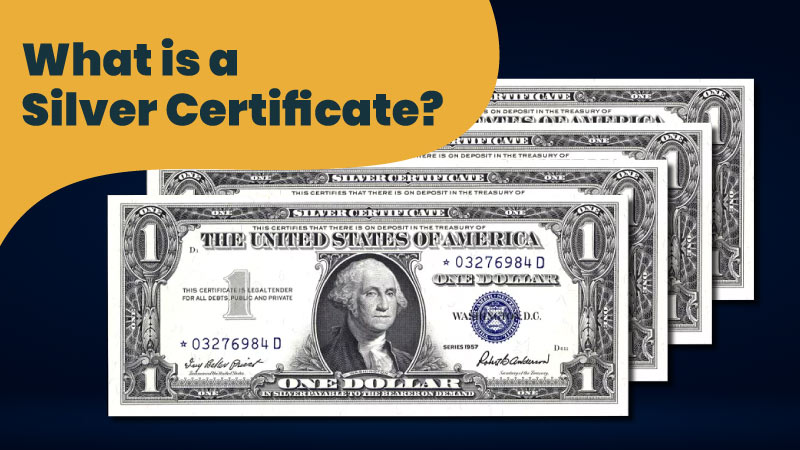What is Silver Certificate

By BullionMentor on October 17, 2023
Silver and gold are the basis of the global economy. They've been used as money for over 2,000 years and have various uses, like in electronics and jewelry. In the past, the United States used to back some of its bills with silver. These bills were called "Silver Certificates". They were once accepted as money but are no longer in use. Let's get deeper into a silver certificate:
Introduction of Silver Certificate
A silver certificate is a special kind of paper money that the U.S. government started printing in 1878. Silver certificates let investors buy silver without needing to hold the actual metal. They represented a particular quantity of silver an investor held and could cash in at any time. People could use these certificates to buy things, just like we use paper money today.
The most famous ones were from the United States and looked like one-dollar bills. The first silver certificates were larger than the later ones. The bigger Silver Certificate Dollar Bills had values from $1 to $1,000, while the smaller ones were mostly in smaller amounts. These certificates had pictures of famous Americans like George Washington, Abraham Lincoln, and Ulysses Grant.
In March 1964, the U.S. Treasury Secretary said that a silver certificate could not be turned into silver dollars anymore, and the government stopped making them shortly afterward.
History of Silver Certificate
First, the Coinage Act of 1873 made government backing mandatory for every dollar in circulation for an equal amount of gold stored in the U.S. Treasury. This move upset silver miners who could no longer get their silver turned into coins at the Mint.
Before, gold and silver were legal tender, with no restriction on minting. But later, the value of silver dropped, and there were restrictions. Supporters of silver, known as "Silverites", formed a "free silver" movement to keep silver in the U.S. monetary system. They won a victory with the Bland-Allison Act of 1878, which made the U.S. Treasury buy millions of dollars worth of silver each month to make into silver coins.
The launch of the Silver Certificate was a more convenient way to exchange value than carrying around silver. Each certificate was backed by the same amount of silver in the U.S. Treasury and exchangeable for that silver. From 1878 to 1923, the first silver certificates were larger than today's paper money and came in various denominations from $1 to $1,000. Later, they got smaller, with denominations of $1, $5, and $10, until the mintage stopped in 1964.
You could trade these certificates for tangible silver for a few more years, but that ended in 1968. Today, Silver Certificate Dollar Bills still have the status of legal money, but collectors value them more than their face value. Other countries like the Netherlands (1914-1938) and Cuba (1934-1949) also had their own silver certificates due to silver shortages.
The introduction of the silver certificate paved the way for today's paper money, which is not backed by any physical item like silver. Instead, central banks control the amount of money in circulation. Even though the minting of silver certificates has halted for over 60 years, collectors still love them for their historical significance.
Series and Varieties of Silver Certificate
During their time in circulation, there were five different sets of Silver Certificates:
- Series 1878 and 1880: These Silver Certificate Dollar Bills came in denominations from $10 to $1,000. They were labeled as "Certificates of Deposit," signifying that the government already deposited the required silver dollars with the U.S. Treasury Department.
- Series 1886, 1891, and 1908: These years expanded the range of available denominations from $1 Silver Certificates to $1,000 notes.
- The "Educational Series" of 1896: This silver certificate series is known for its artistic design and included only three denominations: $1, $2, and $5.
- Series of 1899: Like the "Educational Series," this set featured only the three lower denominations: $1, $2, and $5. The $5 note, known as the "Indian Chief Note," was a stunning example of American artistry, modeled after Chief "Running Antelope."
- Series of 1923 through 1957: During this period, multiple issues of silver certificates were printed, starting in 1923. It marked the transition to smaller dimensions. Notably, these years only produced $1 and $5 notes.
Collectible Silver Certificates
Certain Silver Certificate Dollar Bills are more valuable than their stated face value. Many people are attracted to these certificates because they are valuable and have symbolic significance. Silver certificates remain appealing to both currency collectors and history enthusiasts. They serve as historical artifacts, offering a glimpse into the past and a reminder of significant events. They also show how the currency system has evolved.
You can find various silver certificates to add to your collection, such as the famous Silver Certificate Indian Chief, the Silver Certificate "Educational Series," and those from the World War II era.
While these certificates aren't made of physical silver bullion, there are good reasons to collect them. A silver certificate is artistic and features beautifully designed depictions. It also offers a depiction of American imagery that you won't find on modern paper currency. Silver certificates also provide insight into American monetary history and the years they represent historical significance, particularly for WWII enthusiasts.
Monetary Works of Art
The first silver certificates were like artworks, issued in different amounts from $10 to $1,000. However, people were unsure about using them for transactions. For instance, look at the Educational Silver Certificate Series from the late 1890s. Claude Johnson, who was in charge of making money then, ordered new designs. These designs show things like "History," "Science", and "Electricity" teaching people. Artists made these designs, and they show how artistic paper money can be.
During World War II, special Hawaii overprint notes were launched. They had different colors and markings to be used in case of an invasion. Some notes were damaged during the mintage, and "star notes" were replaced as a solution. For silver certificates, these had an asterisk at the start of the serial number.
Over time, laws changed, and Silver Certificate Dollar Bills stopped in 1968. While collectors or investors might not use them now, many collectors value them for their artistic designs. So, United States Silver Certificates are not just pieces of paper; they are art and also hold a part of history and the past.
Transition from Silver Certificates to Federal Reserve Notes
In the 1960s, the U.S. money system went through changes. Silver certificates promised to give people silver for their money. It became a big deal for collectors and regular people.
Back in the 1800s, silver certificates were exchangeable for real silver dollars. By the 1920s, people could trade them for any silver coins. Then, in the 1960s, silver prices went up, and the government started retiring $5 and $10 silver certificates. They stopped production of the silver certificate altogether.
People were interested in getting silver dollars from the government, and lines at the treasury got long. The government needed to take action. On June 4, 1963, they decided to eliminate the Silver Purchase Act and stop making silver certificates. Instead, they introduced Federal Reserve notes as the new currency for America, even including a further $1 denomination.
Over time, most Silver Certificate Dollar Bills were turned in, and the government stopped giving silver to them. It limited the profit-making schemes. However, it sparked the interest of many new collectors. The world still remembers the notes from that time of the 'silver rush'.
The Value of Silver Certificates Today
The value of silver certificates today depends on two things: how rare it is and its condition. The United States has made these certificates for more than 80 years, and there are many different designs. The ones from the late 1870s and 1880s are rare and usually worth more. The value of a $1 bill silver certificate is very high if it is in perfect condition with no folds or marks.
Collectors also like certificates with lower serial numbers or unique designs. For example, Martha Washington is the only woman on a U.S. silver certificate, which started in 1886, making it more valuable.
The value on the certificate doesn't always matter. A rare $1 silver certificate might be worth more than a $10 one. Some certificates are only worth the printed value—however, a rare one in perfect condition is worth thousands or even millions of dollars.
Conclusion
Silver certificates were a sort of US paper money that promised genuine silver. The government outlawed the exchange of silver certificates for silver dollars in 1964. The U.S. changed to using Federal Reserve Notes as the primary money. Silver certificate series are still valuable today, depending on how rare and well-kept they are. The shift from silver certificates to Federal Reserve Notes in the 1960s significantly changed how money worked in the U.S. People who lived through it still remember the 'Silver Rush' time and appreciate the value of silver certificates.
FAQs
- How much is a silver certificate worth?
- Are silver certificates worth anything?
- What to look for in a silver certificate?
- Grading: Higher grades mean more value.
- Errors: Notes with printing mistakes are worth more.
- Star Notes: Look for those with a star (*) at the start of the serial number.
- Unique Serials: Unlike all zeroes, notes with unusual serial numbers are more valuable.
- What color are silver certificates?
It all depends on what kind of silver certificate you have. If it's a Series 1896 $1 Educational note and in good condition, the value of silver certificates could be worth more than $500. But if it's a $1 Black Eagle Silver Banknote Certificate in the same good condition, it might be worth just over $110.
Silver dollar certificates remind us of a unique time in U.S. history. Today, their worth is equal to the printed amount on them. But for collectors, especially those into rare silver dollars, they can be precious. A silver certificate's value now depends on being a collectible, not just regular money. Its condition and any mistakes in printing matter for its worth. Circulated one-dollar silver certificates in excellent condition are worth more than their printed value. The value of silver certificates of $1 bills can be $2 to $4 each. Yet, rare ones can be worth a lot to collectors.
When checking a silver certificate, remember:
From 1878, U.S. silver certificates had blue seals.
